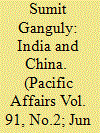|
|
|
Sort Order |
|
|
|
Items / Page
|
|
|
|
|
|
|
| Srl | Item |
| 1 |
ID:
159534


|
|
|
|
|
| Summary/Abstract |
Sino-Indian relations, which have long been fraught, took an especially adverse turn this summer with a military-to-military confrontation on the Doklam Plateau near the India-Bhutan-Tibet trijunction. After several weeks, Indian and Chinese forces withdrew from the region. However, neither side resiled from their respective territorial claims. This episode exemplified the troubles that have come to characterize the Sino-Indian relationship, especially since Prime Minister Modi assumed office in 2014. His regime, which is more nationalistic and reposes greater faith in the utility of force in international politics, had initially sought to diplomatically court the PRC in the hopes of improving their bilateral relationship. However, these efforts did not prove successful. Instead, the People’s Liberation Army, as in the past, continued to undertake limited probes along the Himalayan border, while the PRC continued to make diplomatic, commercial, and strategic inroads into India’s neighbours, trying to reduce India’s influence in those countries. The Modi regime, in turn, sought to counter these initiatives through various efforts of its own in the neighbourhood. Beyond South Asia, India has also sought to enhance its ties with Australia, Japan, the United States, and Vietnam in an attempt to hedge against the PRC’s growing economic and military assertiveness in Asia. These endeavours, however, have elicited hostile reactions from Beijing, which sees New Delhi as the only significant potential hurdle to the expansion of its influence in Asia. Despite Beijing’s adverse reactions it is unlikely that the current regime in New Delhi will scale back its efforts to cope with what it deems to be significant threats emanating from its behemoth northern neighbour.
|
|
|
|
|
|
|
|
|
|
|
|
|
|
|
|
| 2 |
ID:
166817


|
|
|
|
|
| Summary/Abstract |
The Sino-Indian border is one of the longest disputed international borders in Asia. It is also the world highest border which lies on the Himalaya. The Himalaya is a strategically significant to both India and China. The inhabitants of Himalayan regions are a Tibetan stock. According to religious-cultural geography, the Himalayan regions are incorporated into the Tibetan World. Hence, a Tibet factor signifies in the centrality of Sino-Indian border disputes.
|
|
|
|
|
|
|
|
|
|
|
|
|
|
|
|
|
|
|
|
|